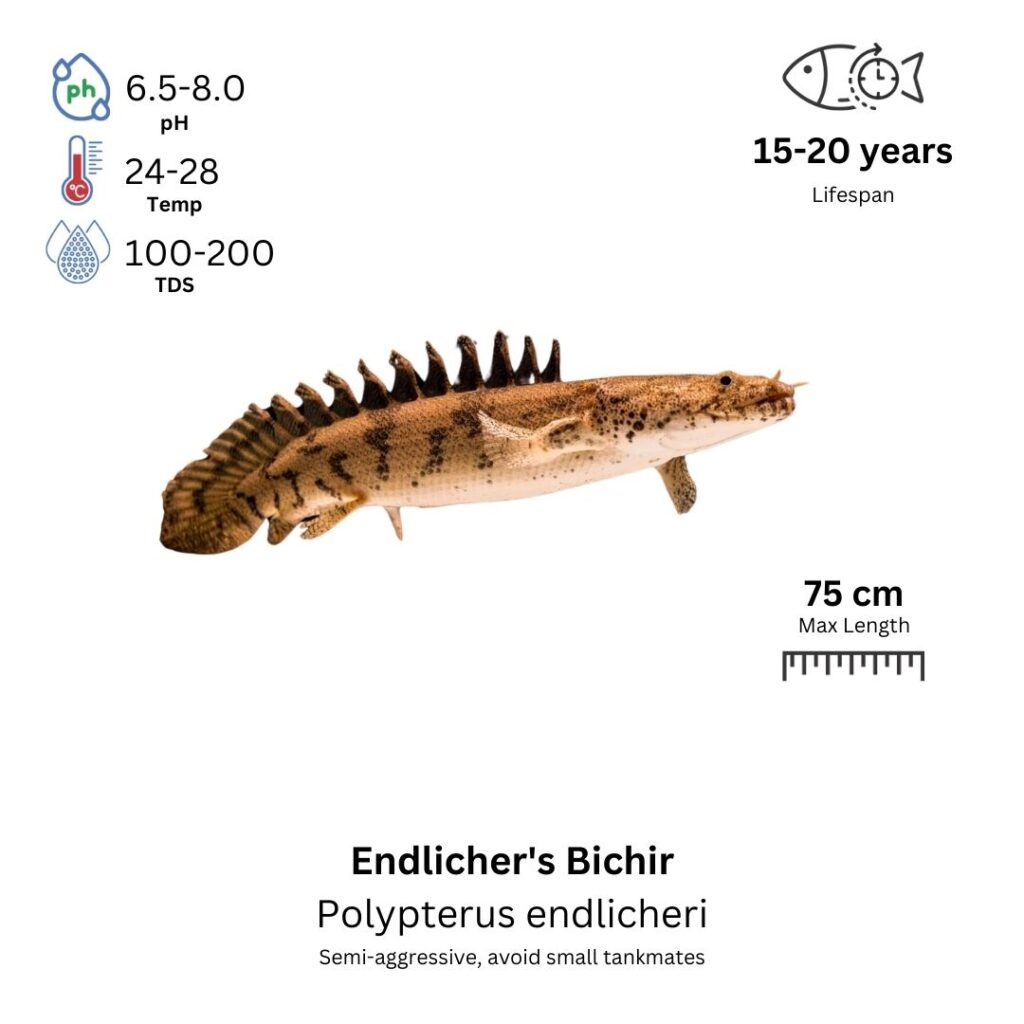Endlicher's Bichir
Polypterus endlicheri

Description
Endlicher’s Bichir is a fascinating and unique species of ancient fish known for its elongated body, armored scales, and primitive characteristics. It has a cylindrical body with prominent, thick, bony plates along the back and sides, giving it a prehistoric appearance. The coloration of the Endlicher’s Bichir varies, usually a brown or olive-green with darker spots or marbling along the body, which helps it blend into its natural environment. Its most distinguishing feature is its large, lobed pectoral fins and the dorsal fin, which consists of a series of finlets. The fish also has an elongated snout with sharp teeth, perfect for catching prey.
Habitat Origin
Endlicher’s Bichir is native to West and Central Africa, primarily found in slow-moving rivers, lakes, and swamps where the water is shallow and muddy. They are adapted to these environments, where they spend much of their time in the bottom layers of the water, hunting and hiding among the substrate. They are also capable of breathing air and can survive in low-oxygen environments for extended periods, making them particularly resilient.
Aquarium
Ideal Number in Aquarium: Best kept singly or in pairs. In larger aquariums, multiple Endlicher’s Bichir can be housed together, but territorial disputes may arise, so space is crucial.
Favorite Food

Endlicher’s Bichir are carnivores and primarily eat meat-based foods. In captivity, they can be fed a variety of live or frozen foods, such as worms, bloodworms, small fish, shrimp, and squid. They may also accept pellets or commercial carnivorous fish food, but live or frozen food should form the bulk of their diet to keep them healthy and active.
Behavior:
Endlicher’s Bichir is a nocturnal and solitary species, spending most of the day hiding in caves, plants, or the substrate. When active at night, it will roam the tank in search of food, using its sharp sense of smell and specialized lobed fins to move. Although they are peaceful with other fish, they can be territorial, especially if they feel crowded or are kept with similarly sized species. Endlicher’s Bichir is known for being a slow, deliberate swimmer and prefers to stay near the bottom of the tank. Their nocturnal nature means they are generally more active in dim lighting.
Special Care:
Endlicher’s Bichir requires a large tank with plenty of hiding spots and space to roam. Since they are bottom dwellers, the substrate should be soft and fine, as rough or sharp gravel can damage their delicate underbelly. Good filtration is important to maintain water quality, as they prefer clean water. Although they can survive in low-oxygen conditions, providing a well-oxygenated environment with adequate water movement is still essential for their overall health. They are hardy but do best in stable, well-maintained aquariums with consistent water parameters.
Compatibility with Other Fish:
Endlicher’s Bichir can be kept with other peaceful, large fish that are too large to be seen as prey. They do not typically bother tankmates but may be territorial with others of their species or similarly sized fish. They are best housed with non-aggressive, robust fish, such as large cichlids, catfish, or peaceful community species that occupy different areas of the tank. Smaller, more delicate species or fast-moving fish may be seen as prey.
Breeding Setup
It is highly recommended to use a separate breeding tank for Endlicher’s Bichir due to their large size and territorial nature. A 200-liter (50-gallon) or larger tank provides sufficient space for the pair to establish territories comfortably. Maintain water parameters with a pH of 6.5 to 7.5, temperature between 26°C to 30°C, and general hardness (GH) of 5 to 12 dGH. Use a high-quality filter that keeps the water clean but produces gentle flow to avoid stressing the fish. A fine substrate like sand or gravel is best, allowing natural burrowing behavior. Add hiding spots such as driftwood or caves to create a secure environment, though plants are optional. Moderate, dim lighting simulates their natural nocturnal habitat and encourages breeding behavior.
Conditioning for Breeding
To prepare Endlicher’s Bichir for spawning, provide a high-protein diet consisting of live foods like worms, brine shrimp, bloodworms, and small fish, along with high-quality carnivorous pellets or frozen mysis shrimp. A protein-rich diet supports health and successful reproduction. Maintain excellent water quality with regular small water changes of about 25% weekly to reduce waste buildup and create optimal breeding conditions.
Spawning
Endlicher’s Bichir are egg-layers that usually spawn during rainy season conditions or when water parameters are ideal. The male courts the female with displays and close following. Females lay hundreds to thousands of sticky eggs on flat surfaces or in crevices, which the male fertilizes. Since parents may eat their own eggs, it’s important to remove the adults after spawning to protect the eggs.
Fry Care
Eggs hatch in 2 to 3 days, depending on water temperature. Newly hatched fry remain attached to surfaces and absorb yolk sac nutrients before becoming free-swimming. Once free-swimming, feed the fry infusoria or microscopic live foods like rotifers. After a few days, gradually introduce baby brine shrimp and small sinking pellets, progressing to crushed carnivorous pellets as they grow. Keep the water pristine with daily small water changes (10-15%), stable temperatures between 26°C and 30°C, and monitor ammonia, nitrite, and nitrate closely.
Important Notes
Endlicher’s Bichir reach sexual maturity between 2 to 3 years; breeding attempts should only be made when they are fully mature. Males are slimmer with brighter fin markings and show more vibrant colors during courtship, while females are larger and rounder, especially when carrying eggs. To reduce stress and aggression, provide ample space for territory establishment, plenty of hiding places, avoid overcrowding, and exclude aggressive tankmates.
